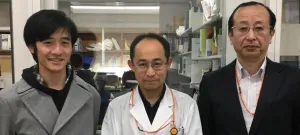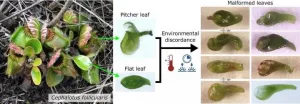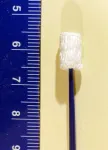Even machines need their greens
Chloroplast-fortified 3D-printer ink may strengthen products like custom sneaker soles
2021-01-27
(Press-News.org) A tree grows strong from years of generating its own food. Now imagine if products could be strengthened with the same living materials that provide nutrients to strengthen trees. This is the work of USC Viterbi School of Engineering Civil and Environmental Engineering Professor Qiming Wang whose research lab is one of the first to infuse 3-D printer ink with living material. The material has potential for greater strength, to be flexible and self-heal. The work is documented in a paper published in The Proceedings of the National Academy of Sciences.
The idea for this bio-inspired ink came from trees that harness the power of photosynthesis to produce glucose that transform to cellulose and strengthen the plant's cell structure. "When trees are young," says Wang, "they are flexible, when they are mature, they are rigid."
"The research idea is also inspired by Popeye the Sailor, the animated character who can strengthen his muscles by eating spinach," says Wang, whose research is focused on bioinspired manufacturing and mechanics of unprecedented materials and structures that can potentially address engineering challenges in infrastructure, energy, robotics, healthcare and the environment.
"Now, we are using scientific innovation to realize our childhood imagination," says Wang.
The research team behind this study, which includes USC Viterbi Ph.D. students Kunhao Yu and Zhangzhengrong Feng as lead authors along with Professor Nicholas X. Fang of Massachusetts Institute of Technology and Professor Chiara Daraio of California Institute of Technology, used a centrifuge to extract chloroplasts from spinach purchased from Trader Joe's. They blended the spinach chloroplasts with a newly invented 3D-printable polymer ink. Then they used the ink to 3D-print structures. By applying light to the 3-printed structure, they created conditions to generate plant-based glucose which reacts with the polymer to make the material become stronger and stronger.
By applying two to four hours of light and mimicking the power of photosynthesis, the researchers believe this "living material" can self-strengthen to be six times its original strength. What's more, the strengthening effect induced by the living chloroplasts can be temporarily suspended by freezing the material at 0? (the chloroplasts are temporarily slowed down at freezing). Once the temperature returns to room temperature, the strengthening effect can be resumed.
"The material behaves like a snake that hibernates through the winter," Wang says.
"Such a temporary 'suspending behavior' has never been demonstrated in existing engineering materials," Wang adds.
Yu, a lead author on the paper notes, "This technology with gradient light illumination can create engineering structures with gradient stiffness, which exhibit an exceptional 'cushioning' property far beyond that of the homogeneous ones.
"Another striking finding is that the strengthening effect can be tuned by external force," said Feng, the paper's other lead author.
"When you hang a weight on a tree branch, that branch will become much stronger than other branches, a process called "mechanotransduction." The same phenomenon happens here.
The team envisions applying photosynthesis to materials to design a custom 3D-printed sneaker sole that molds to one's foot and has a customized stiffness.
Some plants exhibit a self-healing capability during grafting and wound repairing. According to the researchers, the "living material"infused with chloroplasts in a lab at USC also presents an outstanding self-repairing property. Such a property is induced by the photosynthesis-produced glucose that creates the molecular process of cross-linking (in essence equivalent to creating sutures). Such crack-repairing capability could be applied in boat propellers or even drones.
INFORMATION:
ELSE PRESS RELEASES FROM THIS DATE:
2021-01-27
In our body, unnecessary cells are removed by regulated cell death. Understanding of the mechanism underlying regulated cell death is critical for the development of therapies for many diseases. Professor Nakano's research group has demonstrated that Mind bomb-2 (MIB2), a ubiquitin ligase, binds to and directly ubiquitinates the cell death suppressor protein cFLIP (Cellular FLICE-inhibitory protein). cFLIP is encoded by CFLAR gene; alternative splicing results in two forms, the long form (cFLIPL) and the short form (cFLIPs). cFLIPL plays a dominant role in suppression ...
2021-01-27
January 27, 2021 - For many of us, as we get older the skin on our face begins to sag and we seem to lose volume around our eyes, cheeks and chin. Is gravity taking its toll in our later years or do we lose fat over the course of several years that many of us associate with youth, vibrancy and energy? Understanding the cause is paramount to how plastic surgeons treat the signs of facial aging.
The traditional theory is sagging: the facial soft tissues simply yield to the effects of gravity over time. And while the idea that weakening ligaments in the midface could result in soft tissue descent still has merit, more recent studies point in another direction. Perhaps the real culprit behind facial aging ...
2021-01-27
Speaking is something that comes across as an effortless process, almost working by itself. Our brain, however, has a lot of work to do when we construct a sentence. "In addition, languages differ in myriad ways and this also means that there are differences in how we plan what we want to say in different languages," says Balthasar Bickel, senior author of the study and a professor at the University of Zurich.
And if some languages seem easier, it is because they make fewer distinctions in their grammar. While English always uses the (e.g., in "The tree is tall" and "Snow covers the tree"), German makes a distinction between der (subject) and den (object) (e.g., in "Der Baum ist groß" and ...
2021-01-27
A fifth basic flavour has crept into our conceptualisation of foods in recent years--umami. In Japanese, umami translates roughly to 'savoury deliciousness'.
It is often associated with the earthy flavours of meat, mushrooms, broths and vine-ripened tomatoes. It enhances saltiness and sweetness, while reducing bitterness, which is why most people love it.
But does umami exist in beverages? And if so, which fermented beverage has the most umami potential: wine, beer, sake or champagne? And, what happens to flavours when these beverages are paired with foods?
Three researchers from the University of Copenhagen's ...
2021-01-27
Researchers from the Hong Kong University of Science and Technology (HKSUST) and the University of Hong Kong (HKU) recently demonstrated that the selectivity determinant of Origin Recognition Complex (ORC) for DNA binding lies in a 19-amino acid insertion helix in the Orc4 subunit, which is present in yeast but absent in human. Removal of this motif from Orc4 transforms the yeast ORC, which selects origins based on base-specific binding at defined locations, into one whose selectivity is dictated by chromatin landscape (genomic nucleosome profile), a characteristic feature shared by human ORC.
Further understanding of the preferred DNA shapes and nucleosome positioning requirements will provide new insights for the plasticity of the human ORC in selecting replication ...
2021-01-27
Plants and other organisms can adapt their phenotypes to fluctuating environmental conditions within certain limits. The leaves of the dandelion, for example, are much more small in sunny locations than in shady places. In the sun, less leaf area is adequate to drive sufficient photosynthesis. This makes sense and is part of the dandelion's genetic programming.
However, plants can deviate from their normal programming if they are under constant heat stress or other extreme factors that endanger their survival. They then develop, for example, a wide range of leaf shapes that are extremely rare under natural conditions. In this case, scientists ...
2021-01-27
Contracting COVID-19 while pregnant can have deadly consequences for the mother, a new study published today in END ...
2021-01-27
Diabetics living in the UK worry about disruption to insulin supplies as a result of Brexit, new research shows.
Insulin is the hormone that helps control the body's blood sugar level and is critical to the survival of many people living with Type 1 diabetes. Currently most insulin used in the UK is imported.
The research - by the University of York - analysed 4,000 social media posts from the UK and the States in order to explore the experiences of living as an insulin-dependent person. Around 25 per cent of the posts relating to health were made by diabetics and about ...
2021-01-27
Rapid, sensitive diagnosis of COVID-19 is essential for early treatment, contact tracing and reducing viral spread. However, some people infected with SARS-CoV-2 receive false-negative test results, which might put their and others' health at risk. Now, researchers reporting in ACS' Nano Letters have developed ultra-absorptive nanofiber swabs that could reduce the number of false-negative tests by improving sample collection and test sensitivity.
Currently, the most sensitive test for COVID-19 involves using a long swab to collect a specimen from deep inside a patient's nose, and then using a method called reverse transcriptase-polymerase chain reaction (RT-PCR) to detect SARS-CoV-2 RNA. But if the viral load is low, which can occur early in the course of infection, the swab ...
2021-01-27
Widespread use of antibiotics in human healthcare and livestock husbandry has led to trace amounts of the drugs ending up in food products. Long-term consumption could cause health problems, but it's been difficult to analyze more than a few antibiotics at a time because they have different chemical properties. Now, researchers reporting in ACS' Journal of Agricultural and Food Chemistry have developed a method to simultaneously measure 77 antibiotics in a variety of foods.
Antibiotics can be present at trace amounts in meat, eggs and milk if the animals aren't withdrawn from the drugs for a sufficient period of time before the products are collected. Also, ...
LAST 30 PRESS RELEASES:
[Press-News.org] Even machines need their greens
Chloroplast-fortified 3D-printer ink may strengthen products like custom sneaker soles


